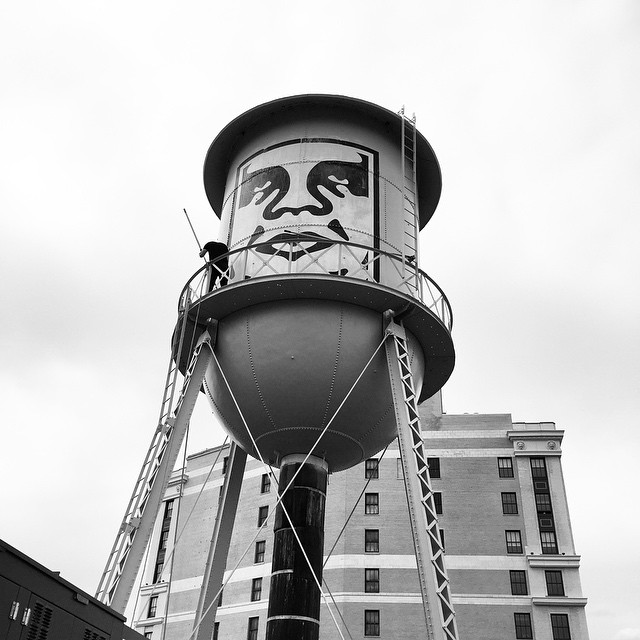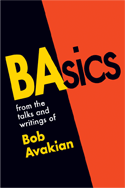From a reader:
Shepard Fairey Arrested for Bringing Some Beauty to Detroit
July 20, 2015 | Revolution Newspaper | revcom.us

Andre the Giant on a water tower in Detroit. (Photo:obeygiant)
Shepard Fairey, world-renowned artist, was arrested in Detroit on July 14 on felony charges. Bail was set at $75,000. He could spend up to five years in jail, with fines that could exceed $10,000.00. There may be more charges added, according to the Detroit News.
The charges were announced to the press on June 24 while Fairey was working in Europe. Fairey was arrested first at Los Angeles International Airport on July 6. He was booked on felony fugitive charges and held overnight. This is his 18th and most serious arrest.
Shepard Fairey was in Detroit in May of this year, commissioned to install an 18-story mural. The police claim he also put up nine to 11 other pieces illegally throughout the city.
Shepard Fairey has always been open about being a street artist, in the finest tradition of the art form that has spread throughout the world since its first major explosion onto the scene in New York in the early 1980s. No apologies here for one of the most important scenes in modern-day art history.
In Detroit, street art has taken on a special meaning in recent years—a virtual blossoming in a city where people have been left in desperate conditions of urban decay and blight.
When the auto industry left the city chasing cheaper labor as part of capitalism’s insatiable competitive drive for profits—combined with the overall economic crises that took an extreme toll in many already distressed cities—Detroit became an urban desert.
Detroit is the poorest large city in America—more than half of the children are impoverished. The city is filled with abandoned buildings—78,000 abandoned and blighted structures. For every 100 residents, there are only 27 jobs. When the city declared bankruptcy in 2013, they cut the pensions of 23,000 retired workers.
Detroit is a living example of American apartheid. 85 percent of the people are African-American. White people live in the suburbs.
This is the city where seven-year-old Aiyana Stanley-Jones was killed by police, captured by a reality TV camera crew who followed a police chase into a wrong apartment. The people of Detroit live every day under the threat of police terror.
This is the city that last year cut off water when people got behind on their bills. In one four- block stretch, 70 percent of the occupied houses went without water. 150,000 families were threatened before human rights organizations called out this practice as against international law.
Detroit has in recent years become a mecca for street art. Many of the world’s most famous streets artists have come to do their own version of urban renewal. Some have even moved to Detroit. An article in Huffington Post by artist Annabel Osberg describes a city covered with paintings. It was a tradition prior to the collapse—whose painted signs on bodega walls were part of its signature. In recent years, the abandoned buildings became blank canvases—including efforts like “The Detroit Beautification Project,” where teams of street artists and local galleries and spray paint companies succeeded in securing approval from building owners to paint murals in Hamtramck, a small city enclosed by Detroit. Osberg describes “Detroit’s unplanned cacophony of work by different artists from different time periods for different purposes ... bold, colorful painting has taken over Detroit, almost in defiance of the city’s breakdown ... empty walls become forums for communication, public diaries. It feels as though the city is literally writings its own history on itself.”
When Mayor Mike Duggan came to office in 2013, he brought with him the now infamous “broken windows” program. This is the policy that fueled the epidemic of mass incarceration and police brutality nationwide—stop-and-frisk where hundreds of thousands of mainly Black and Brown youth in New York City were put up against the wall by police openly based on their appearance; the targeting and dogging of people for small lifestyle crimes (like Eric Garner’s selling of loosies on a street corner) with the philosophy that letting even the smallest infraction, i.e., “broken windows” go, creates an environment of crime. This policy has come under heavy criticism by those standing up against police terror across the country. Duggan continues to openly advocate for its use in Detroit in response to the desperate conditions that people face in this dying city.
He began to go after the street artists. Last December, a piece went up on the side of a community center, which depicted an angel pointing a gun at the police. Two 19-year-olds were arrested and other arrests of street artists followed. He is going after all of the artists now with an aggressive campaign of arrests.
That art has become one of Mayor Duggan’s targets speaks to the ugly gray world he represents.
Art plays a very big role in the overall struggle for human emancipation.
Shepard Fairey has spoken and written extensively about the nature of street art and its impact on how people look at the world around them. He has been proudly part of the tradition that first came up from the urban ghettos as part of a larger culture of rebellion. He has also used his art to make statements about things that he believes matter. If people are not familiar with his art, I highly recommend the collection found in Mayday: The Art of Shepard Fairey—what has been described as a portrait series of underground cultural heroes and apocalyptic landscapes warning about the social effects of social injustice, unjust war, and environmental destruction. He has been instrumental in the further development of a crucially important art form. He talks about how his use of repeated images invading the city landscape—like Andre the Giant and the now iconic Obey piece—can change how people look and walk in the world and how they find their “posse”—and can help people to find each other and collectively represent.
Shepard Fairey, who is probably most known for the image he created for the Obama campaign, recently made a statement that draws attention and controversy. Quoted in the New York Times, he wrote in an email, “I was interested in Obama in 2008 because his stated position at the time made him seem like a subversive delivery vehicle for progressive principles I believe in... Since then, I’ve realized that the corrupt nature of the system itself, with current campaign finance structure and the stranglehold corporations have on government, limits the kind of candidates that will make it into the system and narrows the spectrum of what’s available in our near non-Democracy.”
There is a great deal to appreciate and support in Shepard Fairey’s work. Not only has he been a courageous and fine artist, he has been an artist who has been principled in his engagement with all kinds of progressive causes and has stood up to support the rights of people with different views than his own to be heard, to have their views freely expressed.
The attack on Shepard Fairey must be stopped. People everywhere should speak out and demand the charges be dropped.
Volunteers Needed... for revcom.us and Revolution
If you like this article, subscribe, donate to and sustain Revolution newspaper.

 “Let’s imagine if we had a whole different art and culture. Come on, enough of this 'bitches and ho’s' and SWAT teams kicking down doors. Enough of this 'get low' bullshit. And how come it’s always the women that have to get low? We already have a situation where the masses of women and the masses of people are pushed down and held down low enough already. It’s time for us to get up and get on up.
“Let’s imagine if we had a whole different art and culture. Come on, enough of this 'bitches and ho’s' and SWAT teams kicking down doors. Enough of this 'get low' bullshit. And how come it’s always the women that have to get low? We already have a situation where the masses of women and the masses of people are pushed down and held down low enough already. It’s time for us to get up and get on up.




